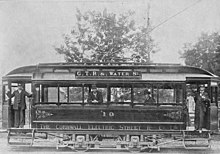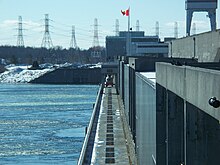Cornwall Electric
It crosses provincial boundaries to obtain the bulk of the power it requires directly from Hydro-Québec, while generating a small amount of its own, using a cogeneration system, a first such use in Canada.
Executives from both companies held meetings and made arrangements that allowed the utility, which had proceeded further in obtaining the name, to continue operating as Cornwall Electric.
[3]: 89–90, 254 In the early 1880s, the owners of the Canada Cotton Manufacturing Company invited employees of Thomas Edison to Cornwall, to install the inventor's direct current (DC) system of incandescent lights, to illuminate their new weaving shed.
[5] H.M. Billsby, director of the project, hired local Cornwall workers, including John MacMillan and Wilbur Reuben (W.R.) Hitchcock, who installed six boilers, six generators, and one hundred carbon filament bulbs connected in series and suspended from the shed's ceiling.
He became a partner at the construction firm Glover, Davis and Hitchcock of New York, installing plants for Westinghouse that produced electricity using an alternating current (AC), which allowed it to travel longer distances, compared to Edison's DC system.
It was passed on to him by his father Andrew Hodge, who years earlier, purchased the mill, which included federal water rights on the Cornwall Canal.
In October of that year, Hitchcock borrowed $5,000 from them to pay his bills, and unable to repay the ten-month loan, he forfeited ownership of his power plant to Stormont Electric.
The offer was declined, and to show its displeasure, the town council decided not to renew the agreement it already had with Stormont Electric and instead placed the street lighting services it provided up for tender.
After much deliberation and finding the St. Lawrence bid too high and reluctant to build a new plant, the town council reversed itself by signing a ten-year contract with Cornwall Electric on June 4, 1902.
[3]: 32 In a 1970 Act of the Legislative Assembly of the Province of Ontario, Cornwall Electric received authorization to sell the railway freight operations, including equipment, buildings, tracks, and lands with rights-of-way.
[15] The debates culminated into a referendum, whereby the ratepayers of Cornwall in a 799 to 540 vote, enacted a by-law to renew the company's franchise, keeping the utility under local control and in private hands for another ten years.
Cornwall Mayor Chisholm and council were outraged and appealed to the provincial government, which, after receiving other complaints, established the Gregory Royal Commission to investigate the HEPC.
[3]: 145–146 Unlike most towns during the depression years of the 1930s, Cornwall was facing industrial expansion and population growth, increasing the demand for more power by 300 percent.
After this, the Cornwall Electric board of directors hired the firm Touche Ross to prepare a feasibility study on purchasing both St. Lawrence Power and Cedar Rapids.
[3]: 292–293 In July 1985, ALCOA announced that it had sold Cedars Rapids Transmission Company Limited to Hydro-Québec for an amount that ranged between 65 and $70 million.
[19][3]: 292–293 The Cedars Rapids Transmission line which crosses provincial and international boundaries feeds Cornwall Electric with the power it requires directly from Hydro-Québec.
[27] As early as 1898, the Sun Life Assurance Company of Canada had begun to purchase bonds issued to Cornwall Electric Street Railway.
Cornwall Electric was in financial trouble and was unable to repay those bonds, giving Sun Life, ownership of the railway company in 1902.
[10] In December 1904, James Leitch, president of Stormont Electric received a letter from Sun Life expressing its desire to purchase the company.
[3]: 89–90 Sun Life consolidated the two operations, sharing management and overhead costs, and using its electricity to power the streetcar services, and to distribute it to consumers.
[10] It made William Hodge, a former director of Stormont Electric, and familiar with the town's people, the first general manager of the combined companies, and who later became the first vice-president.
[3]: 257 The city council, under the leadership of Mayor Gerald Parisien, announced on June 30, 1977 that it sent Sun Life, a letter of intent to purchase the company with an offer of $4.8 million, under a deadline of July 25, 1977.
They were Mayor Gerald Parisien, who also served as president, Albert Bergeron, owner of Bergeron Electric, Fred Bradley, former comptroller at the local textile plant Courtaulds (Canada) Limited, Neil Burke, President of the local car dealership Brookshell Pontiac Buick, and Douglas Fawthrop, former city alderman.
The Cornwall Electric board of directors concerned with the possible adverse impact this could have on the company, presented options to city council.
[19] In 1997, after twenty years of ownership, city council announced that it had made the decision to sell Cornwall Electric to Consumers' Gas Company Ltd.
[30] In May 2002, Enbridge Energy Distribution Inc. (formerly Consumers' Gas), announced that it had agreed to sell Cornwall Electric to Fortis Inc. in a cash deal worth $67 million.
Fortis has its roots in St. John's, Newfoundland, and is a Canadian multinational publicly traded holding company which operates Cornwall Electric under its Ontario subsidiary, FortisOntario Inc.[31] In 2016, Cornwall Electric entered into a ten-year agreement, commencing on January 1, 2020, with Hydro-Québec Energy Marketing, to purchase a minimum of 537 gigawatt hours (GWh) per year and up to 145 megawatts of capacity at any one time.
[20] The sale of Cornwall Electric was set to occur in February 1998 but was delayed due to the January 1998 North American ice storm.
[35] Historically, many of the company's general managers and directors contributed to the future development of Cornwall by working with the local Board of Trade and town council.
Arrangements were also made to purchase the home of W.R. Hitchcock, founder of the Cornwall electric and railway companies who was at the time facing adversity.






